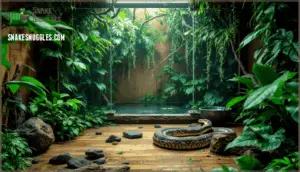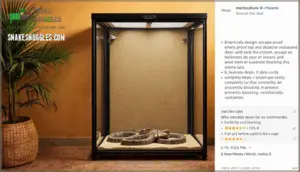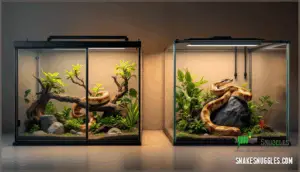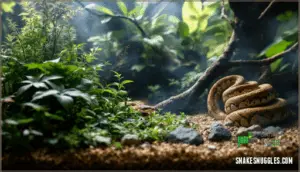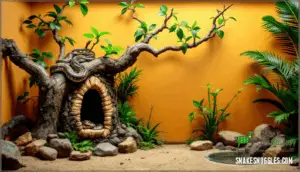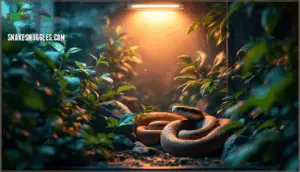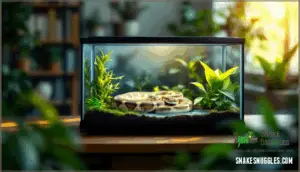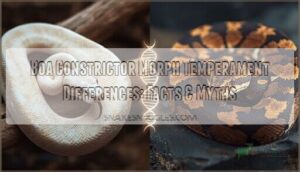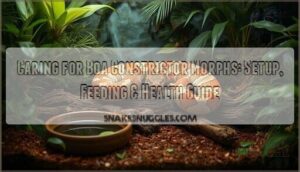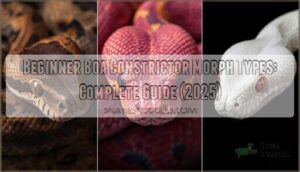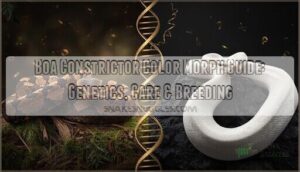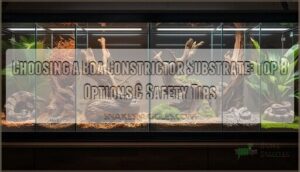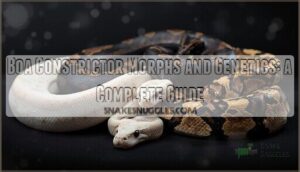This site is supported by our readers. We may earn a commission, at no cost to you, if you purchase through links.

Your boa’s health depends on creating conditions that mirror the temperature gradients, moisture levels, and security it would find in its natural habitat. Getting these fundamentals right from day one prevents most common health problems and helps your snake thrive for its potential 20-30 year lifespan.
Table Of Contents
Key Takeaways
- Boa health depends on precise environmental harmony—temperature gradients, 55-75% humidity, and proper heating work as an interconnected system where even a three-degree error in basking temperature can trigger stress responses and health complications.
- Front-opening enclosures measuring at least 6-8 feet (ideally 8x4x4 feet for adults) with secure latches reduce predator-mimicking stress during interactions, while bioactive substrates like cypress mulch or Terra Firma create self-maintaining ecosystems that manage 95% of waste and cut cleaning frequency dramatically.
- UVB lighting at 2.0-3.0 UVI supports natural vitamin D3 synthesis and calcium absorption in Ferguson Zone 2 species like boas, improving bone health and immune function when bulbs are replaced annually before output degrades.
- Feeding schedules must adapt from weekly hatchling meals to 4-8 week adult intervals using frozen-thawed prey equal to body width, with dietary rotation between rats, mice, and rabbits plus calcium supplementation 2-3 times weekly to prevent metabolic bone disease from captive diet deficiencies.
Choosing The Right Boa Enclosure
Your boa’s enclosure isn’t just a container—it’s their entire world. The right setup keeps your snake healthy, secure, and comfortable for decades to come.
Your boa’s enclosure isn’t just a container—it’s their entire world, keeping them healthy, secure, and comfortable for decades
Let’s walk through the essential features you need to think about when selecting or building the perfect home for your boa.
Minimum and Recommended Enclosure Sizes
While baby boas can squeeze into a glass aquarium, adults need a permanent home that’s at least 6 to 8 feet long and 2 to 3 feet wide.
Though if you’re serious about your snake’s comfort, think bigger. An 8x4x4-foot custom enclosure offers vertical space utilization and lets larger boas move naturally.
Don’t underestimate adult boa needs—cramped quarters stress these powerful constrictors.
Secure and Escape-proof Designs
Even the best enclosure won’t keep your boa safe if it can slip through a crack or pop open the door when you’re not looking. Invest in secure doors with reliable latches—boas are surprisingly strong and persistent escape artists. Check that your mesh top or lid security prevents lifting or bending.
Maintain proper substrate depth without blocking ventilation, hide electrical cords completely, and inspect glass thickness and seals regularly to prevent any gaps.
Front-opening Vs. Top-opening Enclosures
Once your enclosure is locked down tight, you’ll need to decide whether to reach in from the front or hover over your boa from above—and that choice affects how your snake perceives you during every interaction. Front-opening enclosures offer accessibility benefits and reduce stress because you’re not mimicking a predator diving from overhead.
Top-opening designs get the most out of space utilization in smaller rooms but compromise snake security during feeding and cleaning ease, making front access the preferred choice for boa constrictor housing.
Best Substrates for Boas and Bioactive Setups
Substrate choices directly impact substrate moisture control and cleaning frequency throughout your boa’s life. You need materials that maintain just enough humidity without inviting bacterial growth or substrate impaction if accidentally ingested. Selecting snake substrate means balancing your boa’s health against your maintenance schedule—and bioactive terrarium setups shift that equation entirely. One popular option for terrestrial reptiles is a bioactive substrate like Terra Firma.
- Cypress mulch retains moisture well without staying soggy, reducing the risk of respiratory infections while keeping substrate and bioactive setup needs in check.
- Terra Firma Bioactive Kit or similar substrates create self-maintaining ecosystems where cleanup crews manage waste, slashing your cleaning frequency dramatically.
- Cost comparison matters long-term: cheaper substrates require frequent replacement, while bioactive benefits include reduced labor and healthier microbial balance over months.
Essential Hide Boxes and Climbing Structures
Your boa’s sense of security hinges on two non-negotiables: adequate hiding spots and sturdy perches that support its full weight. Provide at least two secure hides—one on the warm side, one on the cool—sized snugly enough that your snake feels enclosed but not trapped.
Climbing branches should be thick enough to bear your boa without bowing, and naturalistic hides blend environmental enrichment with practical enclosure setup, reducing stress while encouraging natural behaviors.
Regulating Temperature, Lighting, and Humidity
Getting the environmental conditions right isn’t just about comfort—it’s about your boa’s health and survival. Temperature, lighting, and humidity work together to support digestion, immune function, and natural behaviors.
Let’s break down how to create and monitor these critical parameters in your boa’s enclosure.
Creating Proper Temperature Gradients
Think of temperature regulation as the thermostat of your boa’s health—without a proper gradient from warm to cool zones, your snake can’t digest food efficiently, fight off infections, or maintain essential metabolic functions. You’ll need a basking spot around 90°F and a cool zone between 75–80°F. Use a digital thermometer to monitor both ends, and always run heat lamps through a dimming thermostat to prevent dangerous overheating.
Essential gradient components:
- Warm end: 90°F basking surface for digestion and thermoregulation
- Cool end: 75–80°F retreat zone for temperature regulation
- Monitoring: Check multiple spots daily with accurate thermometers
Selecting and Positioning Heat Sources
Heat lamps, ceramic heaters, and radiant heat panels each offer distinct advantages—but choosing the wrong one or placing it incorrectly can turn your boa’s enclosure into a dangerous hot spot or leave your snake struggling to thermoregulate.
Overhead heating mimics natural infrared radiation and creates effective temperature gradients for reptiles, while under-tank heating often falls short for larger boas.
Position heat lamps directly above the basking area, secure them with mesh guards for heat source safety, and always run them through calibrated thermostats to prevent thermal burns.
Importance of UVB Lighting for Boas
UVB lighting often gets dismissed as optional for boas—but research tells a different story. When boas have access to proper UVB light, they synthesize vitamin D3 naturally, boosting calcium absorption and supporting stronger bones and healthier immune function.
Studies show UVB intensity around 2.0–3.0 UVI encourages natural sunning habits and improved feeding response. These reptile lighting and heating setups deliver real health benefits, but only if you replace bulbs every 12 months—bulb maintenance matters since output degrades long before the light visibly dims.
Understanding snake lighting requirements means recognizing that UVB light benefits go far beyond preventing disease; they support vitality you can actually observe. Boa constrictors, categorized as Ferguson Zone 2, benefit from this level of UVB exposure.
Maintaining Optimal Humidity Levels
When humidity drifts outside the 55-75% range, you’re not just risking a bad shed—you’re compromising respiratory health, hydration status, and your boa’s ability to thermoregulate effectively. Maintaining humidity levels requires active monitoring and consistent adjustments:
- Install a digital hygrometer to track humidity continuously—analog gauges lack reliability.
- Use misting techniques strategically, targeting substrate moisture rather than saturating the enclosure.
- Provide a humid hide lined with damp sphagnum moss to support shedding success.
- Add a large water bowl to naturally boost ambient humidity through evaporation.
Using Thermostats and Hygrometers Effectively
Without accurate monitoring equipment, you’re practically flying blind—guessing at conditions that could silently harm your boa over weeks or months.
Invest in a reliable digital thermometer and hygrometer, placing probes at both basking and cool zones to verify your temperature gradient. Calibrate your hygrometer regularly and adjust thermostat settings based on real-time data.
Check probe maintenance monthly and establish emergency protocols if equipment fails.
Designing an Enriching Boa Habitat
Once you’ve got the basics of temperature and humidity dialed in, it’s time to think about what goes inside that enclosure. Your boa needs more than just empty space—it needs a habitat that feels secure, encourages natural behaviors, and keeps things interesting.
Let’s look at the key elements that transform a functional setup into a thriving environment.
Incorporating Naturalistic Décor and Branches
Transforming a sterile enclosure into a habitat that mimics your boa’s natural environment isn’t just about aesthetics—it directly impacts your snake’s physical health and behavioral well-being. Strategic décor placement and safe climbing structures provide essential enrichment for these semi-arboreal snakes.
When selecting enclosure décor, prioritize these elements:
- Cleaned, sterilized branches positioned securely for climbing benefits
- Non-toxic safe wood free from pesticides or harmful resins
- Stable rock formations anchored to prevent injury
- Multiple hiding spots at various temperature zones
- Textured surfaces supporting natural behaviors and shedding
Branch sterilization prevents introducing parasites or pathogens into your substrate and bioactive habitat.
Benefits of Live Plants and Bioactive Elements
Live plants and bioactive elements improve your boa’s habitat far beyond simple enclosure decor. A bioactive terrarium setup introduces beneficial microorganisms and detritivores that manage waste breakdown, processing up to 95% of organic material while cutting ammonia levels by half.
This self-sustaining substrate creates a natural microclimate with humidity gradients of 10-20%, supporting thermoregulation without constant manual adjustments. Nutrient cycling from decomposition feeds plant growth, which in turn stabilizes humidity regulation and oxygen levels.
Disease resistance improves as pathogenic bacteria drop by 70%, while environmental enrichment reduces stress behaviors by 30%. Your bioactive habitat becomes a living ecosystem supporting your boa’s health.
Providing Environmental Enrichment and Stimulation
Beyond recreating natural conditions, you’ll need to actively challenge your boa’s problem-solving abilities and movement patterns to prevent cognitive decline and stereotypic actions.
Environmental enrichment for snakes includes rotating novelty items weekly, introducing puzzle feeders that delay prey access, and rearranging enclosure decor to stimulate exploratory snake actions.
Sensory enrichment through scent trails and positive reinforcement during social interaction sessions promotes natural habitat engagement while supporting cognitive health.
Safe Water Sources and Humid Hides
Your boa’s hydration and shedding success depend on two non-negotiables: a sturdy water bowl that won’t tip during soaking sessions and a dedicated humid retreat where moisture levels stay consistently elevated.
Here’s what you need to provide:
- Water bowl size large enough for full-body soaking—generally one-third the snake’s length
- Water source hygiene maintained through twice-weekly cleaning and daily checks for contamination
- Humid hide materials like sphagnum moss, cypress mulch, or paper towels that retain moisture without harboring bacteria
- Humidity monitoring inside the humid hide using a digital hygrometer to confirm 70-80% levels
- Safe misting practices with dechlorinated water to boost humidity levels during shedding cycles
Feeding and Nutrition for Boas
Proper nutrition is fundamental to your boa’s long-term health and vitality. Getting the feeding schedule right, selecting appropriate prey, and using safe techniques will help your snake thrive. Let’s break down what you need to know about feeding your boa constrictor effectively.
Age-appropriate Feeding Frequency
Just like a growing child needs different meal sizes at different ages, your boa’s feeding schedule changes considerably as it matures from a hungry hatchling to a full-grown adult. Hatchling feeding usually occurs weekly with appropriately sized prey items, while juvenile schedules extend to every 10-14 days.
Adult intervals stretch to every 4-8 weeks, depending on body condition. Feeding adult boas less frequently prevents obesity—a common health concern when prey animals are offered too often.
Choosing Suitable Prey Items
The selection of prey animals isn’t just about grabbing whatever’s available at the pet store—you need to match the prey species, size, and nutritional profile to your boa’s developmental stage and individual body condition. Prey size should be roughly equal to the widest part of your boa’s body, preventing regurgitation or injury.
- Frozen-thawed prey is safer than live prey, eliminating bite injuries and parasite transmission risks
- Mice and rats form the feeding schedule foundation, with rabbits appropriate for large adults
- Sourcing prey from reputable suppliers makes certain of proper nutritional balance and disease-free prey items
Safe Feeding Practices and Tools
Once you’ve chosen the right prey item, how you deliver it determines whether feeding time becomes routine care or a trip to the emergency vet. Always use feeding tweezers or hemostats—never your hands—to prevent accidental bites triggered by your snake’s feeding response.
Proper frozen-thawed prey preparation includes thorough thawing and warming to body temperature, which stimulates natural predatory instincts.
Maintain hygiene protocols by sanitizing tools after each feeding and never reusing contaminated equipment.
Importance of Dietary Variety and Supplementation
Feeding your boa the same prey item week after week is like eating nothing but chicken nuggets—nutritionally incomplete. Wild boa diets include mammals, birds, and lizards in nearly equal proportions, while captive prey deficiencies in commercially-bred rodents leave nutritional gaps that supplementation must fill.
Why Dietary Variety and Supplementation Matter:
- Healthier Metabolism – Rotating between rats, mice, chicks, and rabbits provides balanced nutrient profiles that monotonous feeding can’t achieve.
- Calcium Supplements – Apply calcium carbonate powder to your prey item 2–3 times weekly to prevent metabolic bone disease.
- Multivitamin Support – Weekly reptile-appropriate multivitamins address deficiencies common in captive diets, particularly vitamins A and D.
- Supplement Guidelines – Avoid vitamin D3 when using UVB lighting; replace powdered supplements every six months as potency degrades.
- Supplementation Prevalence – Exotic veterinarians routinely recommend this protocol for peak reptile diet and nutrition in carnivorous diet management.
Safe Handling and Boa Health Maintenance
Proper care and consistent health monitoring form the backbone of responsible boa ownership. Your snake’s wellbeing depends on your ability to recognize early warning signs and maintain a clean environment that fosters natural processes like shedding.
Here’s what you need to know to keep your boa healthy and thriving.
Gentle Handling Techniques for Boas
Interacting with a boa constrictor isn’t about domination—it’s about building trust through calm, deliberate movements that communicate safety rather than threat. Start by reading boa body language—relaxed muscles signal comfort, while coiling or hissing means back off.
Always provide secure support along their body, never dangling them freely. Interact gently two to three times weekly to build familiarity without causing stress.
Wash your hands before and after to avoid scent confusion that triggers feeding responses or defensive bites.
Signs of Stress or Illness to Watch For
Recognizing boa constrictor health problems early can mean the difference between a simple fix and a serious veterinary emergency. Behavioral cues, eating habits, and physical signs all tell a story about your snake’s wellbeing.
- Persistent refusal to eat or regurgitation after feeding—over 30% of stressed boas exhibit prolonged anorexia, often signaling systemic illness
- Neurological symptoms like stargazing, tremors, or failure to right itself—classic indicators of infectious disease progression
- Skin irregularities including incomplete sheds, lesions, or visible mites—dysecdysis affects up to 40% of snakes in poorly maintained habitats
- Respiratory distress such as open-mouth breathing or wheezing—commonly linked to improper temperature or humidity levels
Watch for sudden weight loss, lethargy, or abnormal defecation as red flags requiring prompt reptile veterinary care.
Maintaining Enclosure Hygiene
Spotting problems early matters little if the enclosure itself becomes a breeding ground for bacteria, parasites, and fungal pathogens. Disease prevention hinges on consistent waste removal and substrate cleaning—key pillars of snake health.
| Task | Frequency |
|---|---|
| Waste removal | Daily |
| Water sanitation | Every 2-3 days |
| Substrate cleaning | Weekly spot-clean |
| Disinfecting surfaces | Monthly deep-clean |
In bioactive setups, proper humidity and pest control support beneficial organisms while preventing mold. Your snake enclosure’s cleanliness directly impacts respiratory health and immune function.
Supporting Healthy Shedding and Hydration
Shedding isn’t just about old skin peeling away—it’s a window into your boa’s hydration status and overall health. When humidity and substrate moisture drop too low, you’ll see retained shed and dulled skin. Monitor these indicators with a hygrometer:
- Cloudy eyes ("blue phase") signal shedding within 5-7 days
- Complete single-piece shed confirms proper humidity monitoring
- Substrate options like cypress mulch retain moisture better than paper
Soak benefits include loosening stuck skin, though prevention through consistent hydration methods and humidity control works best.
When to Seek Reptile Veterinary Care
Even with diligent care, certain symptoms demand immediate professional attention—and knowing when to call your reptile vet can mean the difference between a treatable issue and a life-threatening emergency. Emergency symptoms like respiratory distress, prolonged regurgitation, or untreated wounds require specialist referrals.
Preventative care and quarantine protocols help you prevent snake diseases before common ailments escalate. Snake veterinary care isn’t optional—it’s essential for identifying snake diseases early and addressing common health and temperament problems effectively.
Frequently Asked Questions (FAQs)
How often should I clean my boas water bowl?
I’ve seen water bowls turn into bacterial soup in just 48 hours, especially after a snake defecates in it.
You should clean your boa’s water bowl daily using reptile-safe disinfection methods to prevent bacteria growth risk and water source contamination, guaranteeing proper hydration and environmental control for suitable snake husbandry.
Can multiple boas live together in one enclosure?
Cohabitation risks in boa constrictor habitat setups are significant. Housing the boa constrictor individually prevents stress factors, disease transmission, and aggression.
Snake enclosure requirements and space requirements increase dramatically with multiple animals, making solitary housing the safest approach for proper snake habitat requirements.
What are signs my boa is ready to eat?
When your boa’s hunting instincts kick into high gear, you’ll notice a shift in conduct. Increased activity levels, tongue flicking, restless movement along enclosure walls, and focused attention signal appetite cues—especially if aligned with your feeding schedule and not during their shedding cycle.
How do I introduce a new boa to its home?
Place your new boa in its prepared enclosure immediately after arrival. Initial Quarantine minimizes disease risk while allowing Gradual Acclimation to its environment.
Keep interaction minimal for 5-7 days, maintain proper Humidity and Substrate conditions, and offer First Feeding after one week for effective Stress Reduction.
Do boas need calcium or vitamin supplements regularly?
When you offer whole prey items, your boa gets complete nutrition—including calcium from bones and vitamins from organs.
Supplementation isn’t usually necessary for boa constrictors or rosy boas on a varied diet of appropriately sized rodents or rabbits.
Conclusion
Your snake doesn’t care that you spent hours researching—it only knows whether its body can thermoregulate properly at 3 AM. Creating a boa-friendly environment isn’t about checking boxes on a setup list; it’s about understanding that each element works as part of an interconnected system.
When your humidity gauge reads correctly, your thermostat responds instantly, and your boa moves confidently between zones, you’ve built more than an enclosure—you’ve created a stable foundation for decades of health.
- https://www.reptifiles.com/red-tailed-boa-care/boa-species-subspecies/.)
- https://www.reptilebasics.com/t5-light-fixtures/shadedweller-prot5-uvb-kit-12/
- https://reptilesandresearch.org/articles/do-snakes-need-uvb
- https://www.reptileacademy.co.uk/post/the-science-of-reptile-husbandry-uvb-ferguson-s-zones
- https://reptifiles.com/boa-constrictor-care/boa-constrictor-uvb-lighting/

